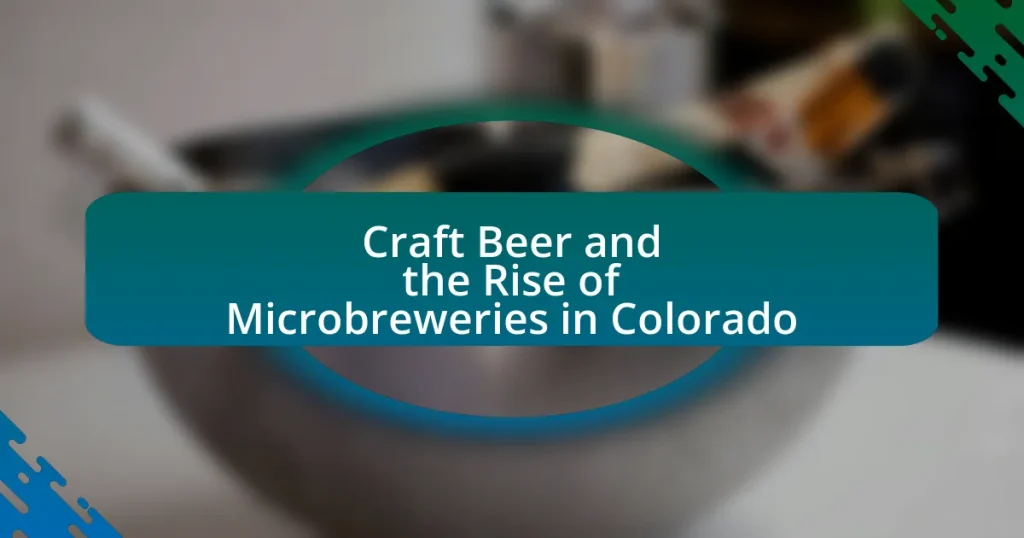Craft beer, produced by small, independent breweries that prioritize quality and traditional brewing methods, has seen significant growth in Colorado, where over 400 microbreweries operate as of 2023. The rise of this industry is attributed to factors such as a strong local culture, favorable regulations, and increasing consumer demand for diverse beer styles. The article explores the historical development of craft beer in Colorado, the defining characteristics of microbreweries, the impact of regulations, and the challenges faced by new entrants. Additionally, it examines trends shaping the future of craft beer, including sustainability practices and consumer preferences, while highlighting the economic benefits of craft beer tourism in the state.

What is Craft Beer and the Rise of Microbreweries in Colorado?
Craft beer is defined as beer produced by small, independent breweries that emphasize quality, flavor, and traditional brewing methods. In Colorado, the rise of microbreweries has been significant, with over 400 craft breweries operating in the state as of 2023, making it one of the leading states for craft beer production in the U.S. This growth is attributed to a combination of factors, including a strong local culture that values artisanal products, a favorable regulatory environment, and a growing consumer demand for diverse and innovative beer styles. The Colorado craft beer industry contributes approximately $3 billion to the state’s economy, showcasing its impact and popularity among residents and tourists alike.
How did the craft beer movement begin in Colorado?
The craft beer movement in Colorado began in the late 1970s when homebrewing became legal in the state, leading to a surge in small-scale breweries. The first commercial craft brewery, Boulder Beer Company, was established in 1979, setting a precedent for others. By the mid-1980s, Colorado had a growing number of microbreweries, driven by a culture of innovation and a desire for diverse beer styles. This growth was further supported by the state’s favorable brewing conditions, including access to high-quality water and a community that embraced local products. As of 2023, Colorado is home to over 400 craft breweries, making it a significant player in the national craft beer scene.
What historical factors contributed to the growth of microbreweries?
The growth of microbreweries was significantly influenced by the deregulation of the brewing industry in the late 20th century, particularly the 1978 legalization of homebrewing in the United States. This legislative change allowed individuals to experiment with brewing techniques and flavors, fostering a culture of craft beer innovation. Additionally, the rise of the craft beer movement in the 1980s and 1990s, driven by a desire for diverse and high-quality beer options, led to an increase in consumer demand for locally produced beverages. The establishment of organizations like the Brewers Association in 2005 further supported microbreweries by providing resources and advocacy, contributing to their proliferation across the country.
How has the culture of craft beer evolved in Colorado?
The culture of craft beer in Colorado has evolved significantly since the late 20th century, transitioning from a few small breweries to a thriving industry with over 400 craft breweries as of 2023. This growth has been fueled by a strong local community that values innovation and quality, leading to a diverse range of beer styles and flavors. The state’s favorable brewing laws, such as the legalization of brewpubs in 1994 and the introduction of the Colorado Craft Beer Week, have further supported this evolution by encouraging entrepreneurship and collaboration among brewers. Additionally, Colorado’s unique geography and climate have allowed for the cultivation of local ingredients, enhancing the distinctiveness of its craft beers.
What defines craft beer and microbreweries?
Craft beer is defined by its small-scale production, independent ownership, and emphasis on quality, flavor, and traditional brewing methods. Microbreweries, which produce craft beer, are typically defined as breweries that produce less than 15,000 barrels annually and are often characterized by their innovative recipes and local community focus. According to the Brewers Association, craft breweries must be independently owned and adhere to specific production limits, ensuring that they prioritize craftsmanship over mass production.
What are the key characteristics of craft beer?
Craft beer is characterized by its small-scale production, emphasis on quality ingredients, and unique flavors. Typically brewed by independent breweries, craft beer often features innovative brewing techniques and a diverse range of styles, such as IPAs, stouts, and sours. According to the Brewers Association, craft breweries must produce less than six million barrels annually and be independently owned, which fosters creativity and local community engagement. This focus on craftsmanship and local sourcing distinguishes craft beer from mass-produced alternatives, contributing to its growing popularity among consumers seeking distinctive and flavorful options.
How do microbreweries differ from larger breweries?
Microbreweries differ from larger breweries primarily in their production scale and business model. Microbreweries typically produce less than 15,000 barrels of beer annually, focusing on quality, flavor, and unique brewing techniques, while larger breweries often produce millions of barrels, emphasizing mass production and distribution. Additionally, microbreweries often prioritize local ingredients and community engagement, fostering a direct relationship with consumers, whereas larger breweries may rely on broader supply chains and marketing strategies. This distinction is supported by the Brewers Association, which defines microbreweries based on production limits and emphasizes their commitment to craft brewing principles.
Why is Colorado a significant hub for craft beer?
Colorado is a significant hub for craft beer due to its high concentration of breweries and a strong culture of craft brewing. As of 2023, Colorado ranks third in the United States for the number of craft breweries, with over 400 establishments, reflecting a vibrant local industry. The state’s favorable climate, access to quality water sources, and a community that supports local businesses contribute to this thriving craft beer scene. Additionally, events like the Great American Beer Festival, held annually in Denver, further solidify Colorado’s reputation as a craft beer destination, attracting enthusiasts and brewers from across the country.
What geographical and climatic factors influence brewing in Colorado?
The geographical and climatic factors influencing brewing in Colorado include elevation, water quality, and temperature variations. Colorado’s high elevation, often exceeding 5,000 feet, affects the boiling point of water, which can alter brewing processes and flavors. The state is also home to pristine water sources, particularly from the Rocky Mountains, providing brewers with high-quality water essential for beer production. Additionally, Colorado experiences a wide range of temperatures, which can impact fermentation and the overall brewing cycle, allowing for diverse beer styles that reflect the local climate. These factors collectively contribute to the unique characteristics of Colorado’s craft beer scene.
How does the local community support microbreweries?
The local community supports microbreweries through patronage, events, and collaboration. Community members frequently visit microbreweries, contributing to their sales and sustainability. Additionally, local events such as beer festivals and tasting events often feature microbreweries, increasing their visibility and customer base. Collaborations with local businesses, such as restaurants and farms, further enhance the microbreweries’ offerings and community ties. For instance, many microbreweries source ingredients from local farms, fostering a sense of community and supporting the local economy.
How have regulations impacted the rise of microbreweries in Colorado?
Regulations have significantly facilitated the rise of microbreweries in Colorado by creating a favorable legal environment for small-scale brewing operations. The state has implemented laws that allow for easier licensing processes, reduced taxes, and the ability for microbreweries to sell directly to consumers, which has encouraged entrepreneurship in the craft beer sector. For instance, the Colorado Craft Beer Act of 2010 streamlined the licensing process and allowed breweries to operate taprooms, directly contributing to the growth of over 400 microbreweries in the state by 2023. These regulatory changes have not only lowered barriers to entry but also fostered a vibrant craft beer culture, making Colorado a leading state in microbrewery development.
What are the key laws governing craft beer production in Colorado?
The key laws governing craft beer production in Colorado include the Colorado Liquor Code, which regulates the manufacturing, distribution, and sale of alcoholic beverages, and the Colorado Craft Beer Act, which specifically supports small breweries by allowing them to sell beer directly to consumers and expand their production limits. Additionally, the state has laws regarding licensing, labeling, and health regulations that breweries must comply with to operate legally. These laws ensure that craft breweries can thrive while maintaining safety and quality standards in the industry.
How have changes in legislation affected microbrewery growth?
Changes in legislation have significantly boosted microbrewery growth by reducing regulatory barriers and allowing for greater market access. For instance, the introduction of laws permitting self-distribution and the sale of beer directly to consumers has enabled microbreweries to operate more freely and reach customers without relying solely on wholesalers. According to the Brewers Association, the number of craft breweries in Colorado increased from 92 in 2011 to over 400 in 2021, largely due to favorable legislative changes that support small businesses in the brewing industry. These legislative reforms have created a more conducive environment for microbreweries to thrive, contributing to their rapid expansion and the overall growth of the craft beer market in Colorado.
What challenges do microbreweries face in Colorado?
Microbreweries in Colorado face several challenges, including regulatory hurdles, competition, and market saturation. Regulatory hurdles involve navigating complex state and local laws regarding licensing, health codes, and distribution, which can be time-consuming and costly. Competition is intense, with over 400 breweries in Colorado, making it difficult for new entrants to establish a foothold. Additionally, market saturation leads to challenges in differentiating products and maintaining profitability, as consumer preferences shift and trends evolve. These factors collectively impact the sustainability and growth potential of microbreweries in the state.
How do competition and market saturation affect microbreweries?
Competition and market saturation significantly impact microbreweries by intensifying the struggle for market share and profitability. As more microbreweries enter the market, they face increased competition, which can lead to price wars and reduced profit margins. For instance, in Colorado, the number of craft breweries has grown from 92 in 2011 to over 400 in 2021, illustrating a saturated market. This saturation forces microbreweries to differentiate their products through unique flavors, branding, and customer experiences to attract and retain customers. Additionally, high competition can lead to challenges in distribution and shelf space, making it harder for new entrants to establish themselves.
What financial hurdles do new microbreweries encounter?
New microbreweries encounter significant financial hurdles, primarily due to high startup costs, operational expenses, and market competition. The initial investment for equipment, licenses, and facility renovations can exceed $500,000, which poses a barrier for many entrepreneurs. Additionally, ongoing costs such as raw materials, labor, and marketing can strain cash flow, especially in the early stages when sales may be unpredictable. According to the Brewers Association, nearly 50% of new breweries fail within the first five years, often due to financial mismanagement and insufficient capital to sustain operations during slow growth periods.

What trends are shaping the future of craft beer in Colorado?
The future of craft beer in Colorado is being shaped by trends such as increased consumer demand for unique flavors, sustainability practices, and the rise of small, independent breweries. Consumers are increasingly seeking innovative and diverse beer options, leading to a proliferation of experimental brews that incorporate local ingredients and unconventional flavors. Additionally, sustainability is becoming a priority, with many breweries adopting eco-friendly practices, such as using renewable energy and reducing water usage. According to the Colorado Brewers Guild, the state has seen a significant increase in the number of microbreweries, which now number over 400, reflecting a shift towards local production and community engagement in the craft beer scene.
How is consumer preference evolving in the craft beer market?
Consumer preference in the craft beer market is increasingly shifting towards unique flavors, local sourcing, and sustainable practices. This evolution is evidenced by a growing demand for innovative styles, such as sour ales and barrel-aged beers, which cater to adventurous palates. Additionally, a 2022 survey by the Brewers Association indicated that 70% of craft beer drinkers prioritize local breweries, reflecting a preference for community engagement and support. Furthermore, consumers are becoming more environmentally conscious, with many favoring breweries that implement eco-friendly practices, such as using renewable energy and sustainable packaging. This trend highlights a significant transformation in consumer values, emphasizing quality, locality, and sustainability in their craft beer choices.
What role do sustainability and local sourcing play in consumer choices?
Sustainability and local sourcing significantly influence consumer choices, particularly in the craft beer industry. Consumers increasingly prefer products that are environmentally friendly and support local economies, leading to a rise in demand for microbreweries that emphasize these values. A survey by Nielsen found that 66% of global consumers are willing to pay more for sustainable brands, indicating a strong preference for products that align with their values. Additionally, local sourcing reduces transportation emissions and fosters community relationships, further appealing to environmentally conscious consumers. This trend is evident in Colorado, where many microbreweries prioritize local ingredients and sustainable practices, attracting customers who value these attributes.
How are flavor innovations influencing craft beer offerings?
Flavor innovations are significantly influencing craft beer offerings by expanding the range of unique and diverse flavors available to consumers. Craft breweries are increasingly experimenting with unconventional ingredients such as fruits, spices, and herbs, which allows them to create distinctive brews that cater to evolving consumer preferences. For instance, a report from the Brewers Association indicates that craft breweries in Colorado have seen a rise in the popularity of sour ales and fruit-infused beers, reflecting a shift towards more adventurous flavor profiles. This trend not only attracts new customers but also encourages existing beer enthusiasts to explore a broader spectrum of tastes, ultimately driving growth in the craft beer market.
What impact does tourism have on Colorado’s craft beer scene?
Tourism significantly boosts Colorado’s craft beer scene by increasing demand for local breweries and attracting visitors to beer festivals and tasting events. In 2022, Colorado’s craft breweries produced over 1.1 million barrels of beer, with tourism contributing to a 10% increase in sales compared to the previous year. The state’s reputation as a craft beer destination draws approximately 30 million visitors annually, many of whom seek out local breweries, thus enhancing the economic viability of these establishments and fostering a vibrant beer culture.
How do beer festivals and events promote local breweries?
Beer festivals and events promote local breweries by providing a platform for them to showcase their products directly to consumers. These gatherings attract large crowds, allowing breweries to increase brand visibility and engage with potential customers. For instance, the Great American Beer Festival, held annually in Denver, features hundreds of breweries and draws tens of thousands of attendees, significantly boosting local sales and awareness. Additionally, such events often include educational sessions and tastings, which help consumers learn about the brewing process and the unique qualities of local beers, further enhancing community support for these breweries.
What are the economic benefits of craft beer tourism for Colorado?
Craft beer tourism generates significant economic benefits for Colorado by boosting local economies, creating jobs, and increasing tax revenues. The craft beer industry in Colorado contributes over $3 billion annually to the state’s economy, with more than 400 breweries attracting millions of visitors each year. This influx of tourists supports local businesses, including restaurants, hotels, and retail shops, enhancing overall economic activity. Additionally, the industry provides thousands of jobs, with the Colorado Brewers Guild reporting over 20,000 jobs directly related to craft brewing. Furthermore, craft beer tourism contributes to state and local tax revenues, which can be reinvested into community services and infrastructure.
How are technology and social media influencing microbreweries?
Technology and social media are significantly influencing microbreweries by enhancing their marketing strategies and customer engagement. Microbreweries utilize social media platforms like Instagram and Facebook to showcase their products, share brewing processes, and connect with local communities, which has been shown to increase brand visibility and customer loyalty. For instance, a study by the Brewers Association indicates that 70% of craft beer consumers engage with breweries on social media, leading to higher foot traffic and sales. Additionally, technology facilitates online ordering and delivery services, allowing microbreweries to reach a broader audience beyond their local area, further driving growth in the competitive craft beer market.
What digital marketing strategies are effective for microbreweries?
Effective digital marketing strategies for microbreweries include social media engagement, content marketing, email marketing, and local SEO. Social media platforms like Instagram and Facebook allow microbreweries to showcase their products visually and interact with customers, which is crucial given that 54% of consumers use social media to research products. Content marketing, such as blogs and videos about brewing processes or beer pairings, helps establish authority and attract an audience. Email marketing enables direct communication with customers, fostering loyalty; studies show that email marketing has an average ROI of $42 for every dollar spent. Local SEO is vital for microbreweries to appear in local searches, as 46% of all Google searches are seeking local information, ensuring that potential customers can easily find them.
How does technology enhance the brewing process?
Technology enhances the brewing process by improving efficiency, consistency, and quality control. Automated systems allow for precise temperature and timing management during fermentation, which leads to more consistent flavor profiles. Additionally, advanced brewing equipment, such as digital mash tuns and fermentation tanks with built-in sensors, enables brewers to monitor and adjust variables in real-time, ensuring optimal conditions for yeast activity. Furthermore, data analytics tools help brewers analyze past batches to refine recipes and processes, ultimately resulting in higher quality craft beer.

What are the best practices for starting a microbrewery in Colorado?
The best practices for starting a microbrewery in Colorado include thorough market research, compliance with state regulations, and effective branding. Conducting market research helps identify local demand and competition, which is crucial for positioning the microbrewery successfully. Compliance with Colorado’s Alcohol and Gaming Enforcement Division regulations ensures that all legal requirements are met, including licensing and health standards. Effective branding, including a unique name and logo, helps differentiate the microbrewery in a crowded market, which is essential given that Colorado has over 400 breweries as of 2023. These practices are vital for establishing a sustainable and successful microbrewery in the state.
What steps should aspiring brewers take to launch a microbrewery?
Aspiring brewers should take the following steps to launch a microbrewery: conduct thorough market research, create a detailed business plan, secure financing, choose a suitable location, obtain necessary licenses and permits, purchase equipment, develop recipes, and implement marketing strategies.
Market research helps identify target demographics and competition, which is crucial for success in the craft beer industry. A business plan outlines the vision, goals, and financial projections, serving as a roadmap for the microbrewery. Securing financing can involve personal savings, loans, or investors, as starting a microbrewery typically requires significant capital, often ranging from $250,000 to over $1 million depending on scale.
Choosing a location is vital; it should have high foot traffic and align with local regulations. Obtaining licenses and permits, such as a federal brewer’s notice from the Alcohol and Tobacco Tax and Trade Bureau (TTB) and state-level permits, is legally required to operate. Purchasing equipment, including brewing kettles, fermenters, and kegs, is essential for production. Developing unique recipes can differentiate the microbrewery in a competitive market. Finally, implementing effective marketing strategies, such as social media engagement and local events, can help build a customer base and brand recognition.
How important is market research before starting a microbrewery?
Market research is crucial before starting a microbrewery. It helps entrepreneurs understand consumer preferences, identify market trends, and assess competition. For instance, a study by the Brewers Association indicates that 80% of new breweries fail within the first five years, often due to a lack of market understanding. Conducting thorough market research can reveal insights about local demographics, popular beer styles, and pricing strategies, which are essential for making informed business decisions. This data-driven approach significantly increases the likelihood of success in the competitive craft beer industry.
What resources are available for new microbrewers in Colorado?
New microbrewers in Colorado can access a variety of resources including the Colorado Brewers Guild, which provides advocacy, education, and networking opportunities. Additionally, the state offers programs through the Colorado Office of Economic Development and International Trade that assist with funding and business development. The Brewers Association also offers resources such as industry statistics, marketing support, and educational materials tailored for small breweries. These organizations collectively support the growth and sustainability of new microbreweries in the region.
What common mistakes should new microbreweries avoid?
New microbreweries should avoid underestimating the importance of market research. Conducting thorough market analysis helps identify target demographics, local competition, and consumer preferences, which are crucial for successful positioning. According to the Brewers Association, 50% of new breweries fail within the first five years, often due to a lack of understanding of their market. Additionally, new microbreweries should not neglect financial planning; inadequate budgeting can lead to cash flow issues. A study by the Small Business Administration indicates that 30% of small businesses fail due to poor financial management. Lastly, new microbreweries must avoid compromising on quality; inconsistent product quality can damage reputation and customer loyalty. Research shows that 60% of craft beer consumers prioritize quality over price, emphasizing the need for high standards in brewing.
How can financial mismanagement impact a microbrewery’s success?
Financial mismanagement can severely hinder a microbrewery’s success by leading to cash flow issues, inability to meet operational costs, and ultimately, business failure. For instance, if a microbrewery fails to accurately track expenses and revenues, it may overspend on ingredients or equipment, resulting in insufficient funds to cover essential expenses like payroll or rent. According to a study by the Brewers Association, nearly 30% of small breweries fail within the first three years, often due to financial mismanagement. This statistic underscores the critical importance of sound financial practices in ensuring sustainability and growth in the competitive craft beer market.
What operational pitfalls should be considered in the brewing process?
Operational pitfalls in the brewing process include contamination, inconsistent temperature control, and inadequate sanitation practices. Contamination can occur from wild yeast or bacteria, leading to off-flavors and spoilage, which can significantly affect product quality. Inconsistent temperature control during fermentation can result in undesirable flavors and aromas, as yeast activity is highly sensitive to temperature fluctuations. Additionally, inadequate sanitation practices can introduce pathogens or spoilage organisms, compromising the safety and quality of the beer. These pitfalls are critical to address, as they can lead to financial losses and damage to a brewery’s reputation in the competitive craft beer market.
What resources can help microbreweries thrive in Colorado?
Microbreweries in Colorado can thrive by utilizing resources such as the Colorado Brewers Guild, which provides advocacy, education, and networking opportunities for local brewers. Additionally, the Small Business Development Center (SBDC) offers consulting services and workshops tailored to the brewing industry, helping entrepreneurs navigate business challenges. Furthermore, access to local ingredients through Colorado’s agricultural network enhances product quality and supports sustainability. The state’s craft beer culture, supported by events like the Great American Beer Festival, also provides exposure and marketing opportunities for microbreweries. These resources collectively contribute to the growth and success of microbreweries in Colorado.
How can networking with other brewers benefit new microbreweries?
Networking with other brewers can significantly benefit new microbreweries by providing access to shared knowledge, resources, and industry connections. This collaboration allows new entrants to learn best practices in brewing techniques, marketing strategies, and operational efficiencies from established brewers, which can enhance their product quality and business acumen. For instance, a study by the Brewers Association indicates that breweries that engage in collaborative brewing projects often see increased visibility and customer interest, leading to higher sales. Additionally, networking can facilitate partnerships for events, distribution, and sourcing ingredients, which are crucial for the sustainability and growth of new microbreweries in a competitive market like Colorado.
What role do local organizations play in supporting microbreweries?
Local organizations play a crucial role in supporting microbreweries by providing resources, networking opportunities, and advocacy. These organizations often facilitate collaboration among microbreweries, helping them share best practices and access shared marketing platforms. For instance, the Colorado Brewers Guild actively promotes the interests of local breweries, offering educational programs and legislative support that can enhance the operational landscape for microbreweries. Additionally, local organizations may host events such as beer festivals, which not only increase visibility for microbreweries but also foster community engagement and consumer interest in craft beer.


